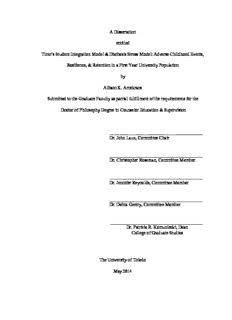
Tinto's Student Integration Model & Diathesis Stress Model: Adverse Childhood Events, Resilience ... PDF
Preview Tinto's Student Integration Model & Diathesis Stress Model: Adverse Childhood Events, Resilience ...
A Dissertation entitled Tinto’s Student Integration Model & Diathesis Stress Model: Adverse Childhood Events, Resilience, & Retention in a First Year University Population by Allison K. Arnekrans Submitted to the Graduate Faculty as partial fulfillment of the requirements for the Doctor of Philosophy Degree in Counselor Education & Supervision _________________________________________ Dr. John Laux, Committee Chair _________________________________________ Dr. Christopher Roseman, Committee Member _________________________________________ Dr. Jennifer Reynolds, Committee Member _________________________________________ Dr. Debra Gentry, Committee Member _________________________________________ Dr. Patricia R. Komuniecki, Dean College of Graduate Studies The University of Toledo May 2014 Copyright 2014, Allison K. Arnekrans This document is copyrighted material. Under copyright law, no parts of this document may be reproduced without the expressed permission of the author. An Abstract of Tinto’s Student Integration Model & Diathesis Stress Model: Adverse Childhood Events, Resilience, & Retention in a First Year University Population by Allison K. Arnekrans Submitted to the Graduate Faculty as partial fulfillment of the requirements for the Doctor of Philosophy Degree in Counselor Education & Supervision The University of Toledo May 2014 While budgets are being cut and positions not being refilled, it is no surprise that universities are also beginning to feel the effects of a weakened economy. Student retention has remained a prominent issue in the literature for several decades now, still with no definite answer on why students fail to persist and graduate (Morrow & Ackerman, 2012). In an effort to gain more insight into this phenomenon, the purpose of this study is to understand retention by assessing resiliency in students who have experienced adverse childhood events. The goal of this study is to identify if resiliency, as a psychosocial factor, influences student persistence in the first year at a university when the student is identified as at-risk (i.e. the student has dealt with an identified past trauma). An agglomeration of Tinto’s Student Integration Model and the Diathesis Stress Model will be used to understand how resilience and psychopathology can affect persistence decisions in the first year. If services can be implemented for students in their first year, it is possible that more students would persist and graduate. Keyword(s): resilience, retention, Student Integration Model, Diathesis Stress Model iii To my family, friends, colleagues, and professors…thank you for your support and encouragement of my success! Acknowledgements My graduate career, especially this dissertation, could not have come to fruition without the loyal support of my family, friends, and colleagues. Each of them has been flexible with their time and resources as I pursued this important goal of mine. A big “tack så mycket” to my extended Swedish family across the pond, who have remained helpful and excited about my successes. I am also very thankful to my dissertation committee, consisting of Dr. Christopher Roseman, Dr. Jennifer Reynolds, and Dr. Debra Gentry- I appreciate your attention to detail, your valuable input, and the time you took to mentor this project. Finally, I would like to thank my dissertation chair and program advisor, Dr. John Laux. He has been supportive of my success since day one as a Masters Student and I would not have been challenged or pushed to greater things without this support. His mentorship is valued and his commitment to students is unparalleled. v Table of Contents Abstract iii Acknowledgements v Table of Contents vi List of Tables ix List of Figures x List of Symbols xi 1. Introduction 1 A. Resiliency in At-risk University Freshmen 1 B. Definition of Terms 5 C. Environmental Stressors 8 D. Resilience Literature 13 E. Diathesis Stress Model 16 F. Tinto’s Student Integration Model 17 G. Theory Integration 18 H. Problem Statement 20 I. Purpose Statement 20 J. Research Questions 20 K. Significance of the Study 21 2. Literature Review 23 A. University Freshmen Population & Retention 23 a. Risk Factors for Low Retention 24 b. Protective Factors 28 vi c. Transition Model 30 d. Retention Efforts 32 B. Resilience 34 a. History of Term “Resilience” 35 C. Scales 40 a. Child & Adolescent Resiliency Scales 40 b. Adult Resiliency Scales 42 c. Scale Critiques 44 d. The Resilience Scale (RS) 46 e. Connor-Davidson Resilience Scale (CD-RISC) 47 D. Diathesis Stress Model 49 E. Tinto’s Student Integration Model 51 F. Theory Integration 54 3. Methods 57 A. Research Questions 57 B. Research Design 58 C. Instruments 60 a. Resilience Scale (RS) 61 b. Connor-Davidson Resilience Scale (CD-RISC) 62 c. Demographic Questionnaire 64 D. Procedures 64 E. Variables 67 F. Research Hypotheses 68 vii G. Data Analysis 69 H. Ethical Considerations 70 4. Results 73 A. Sample/Participants 73 B. Descriptive Data 74 C. Research Questions 77 D. Post-hoc Analyses 80 5. Discussion 83 A. Background and Study Findings 83 B. Integration of Findings into the Literature 89 C. Implications 94 a. Higher Education Administrators 94 b. Practicing Counselors 96 c. Counselor Educators 97 D. Limitations 98 E. Suggestions for Future Research 100 References 105 Appendices 117 A. Institutional Review Board (IRB) Approval Form 123 B. Demographic Data Form 124 C. Resilience Scale (RS) 125 D. Connor- Davidson Resilience Scale (CD-RISC) 126 viii List of Tables Table 1 Score Means, Standard Deviations, and Ranges of Scores for the Two Resilience Scales .............................................................................................78 Table 2 Means and Standard Deviation Scores for GPA and Traumatization Status................................................................................................................80 Table 3 Resilience Scale Scores based on Persistence Status………………………...81 ix List of Figures Figure 1 Diathesis Stress Model ...........................................................................17 & 51 Figure 2 Tinto’s Student Integration Model (Tinto, 1975) ..................................18 & 53 Figure 3 Tinto’s Student Integration Model & Diathesis Stress Model Combined……………………….. ..........................................................19 & 55 x
Description: